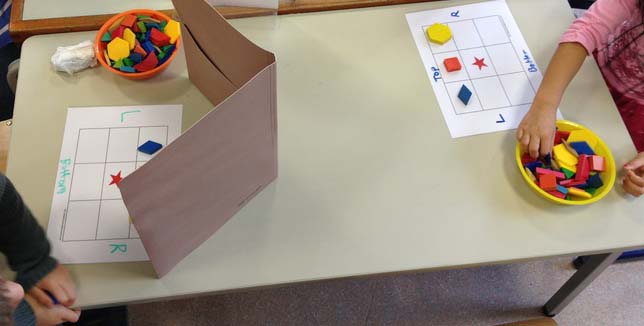Toy shelf
0
Overview
Using this Resource
Connecting to the Curriculum
Marking Student Responses
Working with Students
Further Resources
This task is about where some toys are on some shelves.
|
Nikau keeps his toys on some shelves.
|
 |
Task administration:
This task can be completed with pencil and paper or online with auto-marking displayed to students.
Level:
1
Curriculum info:
Description of task:
Students identify objects on a shelf from given positional descriptions (above, below, over, under, beside, next to).
Curriculum Links:
This resource can be used to help to identify students' understanding of simple direction.
Learning Progression Frameworks
This resource can provide evidence of learning associated with within the Mathematics Learning Progressions Frameworks.
Read more about the Learning Progressions Frameworks.Answers/responses:
| Y2/3 (03/2017) | ||
| a) |
 |
very easy |
| b) |
 |
very easy |
| c) |
 |
very easy |
| d) |
 |
very easy |
| e) |
 |
very easy |
| f) |
 |
very easy |
Based on an online sample of 25 students
Teaching and learning:
This resource can be used to find out about students' understanding of everyday positional language.
It can be used with a class, a small group or individuals.
The resource has been designed to be suitable for ESOL students.
Diagnostic and formative information:
A common error among students was to choose the object that was given in the original statement rather than the object next to/above/below it.
Next steps:
Students who selected the object that was already given may need help with reading the question. Students could read the question in pairs, small groups or as a class, discussing the words in bold and what they might mean.
For students who were able to correctly identify the objects, further questions could be posed using the picture of the toys on the shelf. The toy shelf image could be projected onto a large screen or used with a group on a device, or devices, or printed out and enlarged.
Students could also use classroom objects (toys, blocks, counters etc) and make their own 'toy shelf'. They could then describe the position of various items on the 'shelf' in relation to a chosen item. This could be done in pairs.
Barrier or Hidden Picture Games
As a next step students could use simple grids (starting with a 2x2 grid and building up to a 2x3, 3x3, 4x4, or larger grid) and play barrier games.

One student has a grid with simple shapes or numbers drawn or placed on it and has to describe the positions of each shape or number to a partner who cannot see the grid. A barrier is placed between the two students.
Here are some websites with ideas and links to examples of barrier games:
- http://www.eal-teaching-strategies.com/barriergames.html
- http://www.sparklebox.co.uk/maths/shape-space-measures/position.html#.WM...
Obstacle Course/Playground
Students can give directions to each other about how to move through an obstacle course created with classroom furniture and/or PE equipment or on the playground e.g. "Go up the ladder, go down the slide, go left to the cargo net, go under the cargo net..." etc.
Giving Directions
Students can give directions to each other, or to an adult, about how to get from one place to another e.g. from one part of the classroom or playground to another part.
There are also a number of Level 1 and 2 resources involving giving or understanding directions:
- Which book? (Level 1/2)
- Giving directions (Level 2)
- Going to Stephanie's house (Level 2)
For a Level 1/2 English resource that has a focus on everyday prepositional language, e.g., 'on', 'in', 'up' and 'down'. see Where do they go?

